
Owners
They have invested in the business by providing capital. They would like to have information on
the position performance and changes in the financial position in order to assess the profitability
of their investments, stewardship of the firm by the managers and how much returns they
expect.
Financial analysts
Financial Analysts and advisors interpret financial information.(These include brokers and
consultants) They need information on the financial position and performance so advice their
clients ( or potential investors ) as to profitability and the value of the investment. Other
advisors include the press who will pass the information to the public or interested parties.
Lenders
Lenders have provided loans (both long-term e.g. debentures and short-term e.g. overdrafts) to
the firm. They would like to have information about the firms financial performance and
position so as to assess whether the firm is profitable enough to pay the interest on loans and
the principal amount when it becomes due.
Mutiso answered the question on November 17, 2018 at 11:10
-
Briefly explain three circumstances under which “goodwill” can be recorded in a business firm's books of account
(Solved)
Briefly explain three circumstances under which “goodwill” can be recorded in a business firm's books of account.
Date posted:
November 17, 2018
.
Answers (1)
-
The following balances remained in the books of Ahadi Ltd. as at 30 April 2003 after the preparation of the trading account:
(Solved)
The following balances remained in the books of Ahadi Ltd. as at 30 April 2003 after the preparation of the trading account:
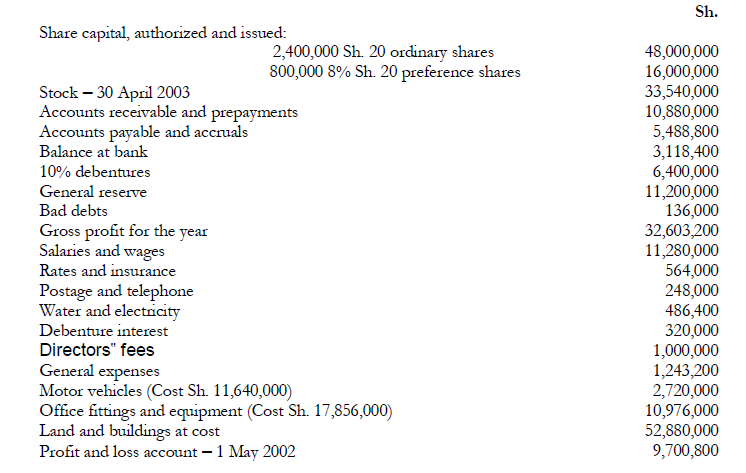
Additional information:
1. A bill for Sh. 219,200 in respect of electricity for the period up to 30 April 2003 has
not been accrued.
2. The amount for insurance includes a premium of Sh. 120,000 paid in January 2003
to cover the company for six months, February to July, 2003.
3. Office fittings and equipment are to be depreciated at 15% per annum on cost
and motor vehicles at 20% per annum on cost.
4. Provision is to be made for:
Directors‟ fees - Sh. 2,000,000
Audit fee - Sh. 480,000
The outstanding debenture interest.
5. The directors have recommended that:
- A sum of Sh. 4,800,000 be transferred to general reserve.
- The preference dividend be paid.
- A 10% ordinary dividend be paid.
Required:
(a) Profit and loss and appropriation accounts for the year ended 30 April 2003.
(b) Balance sheet as at 30 April 2003.
Date posted:
November 17, 2018
.
Answers (1)
-
You have recently been employed in a medium size company and deployed in the accounts department. Your head of section has given you the following...
(Solved)
You have recently been employed in a medium size company and deployed in the accounts department. Your head of section has given you the following extract from the cashbook for the month of April 2003.

The head of section further informs you that all receipts are banked intact and all payments are
made by cheque. On investigation, you discover the following:
1. Bank charges and commissions amounting to Sh. 272,000 entered on the bank
statement had not been entered in the cashbook.
2. Cheques drawn amounting to Sh. 534,000 had not been presented to the bank for
payment.
3. Cheques received totaling Sh. 1,524,000 had been entered in the cashbook and paid into
the bank, but had not been credited by the bank until May 2003.
4. A cheque for Sh. 44,000 had been entered as a receipt in the cashbook instead of a
payment.
5. A cheque for Sh. 50,000 had been debited by the bank by mistake.
6. A cheque received for Sh. 160,000 had been returned unpaid. No adjustment had been
made in the cashbook.
7. All dividends receivable are credited direct to the bank account. During the month of
April 2003. Dividends totaling Sh. 124,000 were credited by the bank and no entries had
been made in the cashbook.
8. A cheque drawn for Sh. 12,000 had been incorrectly entered in the cash book as Sh.
132,000.
9. The balance brought forward should have been Sh. 1,422,000.
10. The bank statement as at 30 April 2003 showed on overdraft of Sh. 2,324,000.
Required:
(i) The adjusted cashbook as at 30 April 2003.
(ii) Bank reconciliation statement as at 30 April 2003.
Date posted:
November 17, 2018
.
Answers (1)
-
Briefly explain why it is important for a business entity to prepare a bank reconciliation statement
(Solved)
Briefly explain why it is important for a business entity to prepare a bank reconciliation statement
Date posted:
November 17, 2018
.
Answers (1)
-
Differentiate between a petty cashbook and a three-column cashbook
(Solved)
Differentiate between a petty cashbook and a three-column cashbook.
Date posted:
November 17, 2018
.
Answers (1)
-
The following balances have been extracted from the books of Limuru Manufacturers, a small scale manufacturing enterprise, as at 31 December 2002:
(Solved)
The following balances have been extracted from the books of Limuru Manufacturers, a small scale manufacturing enterprise, as at 31 December 2002:
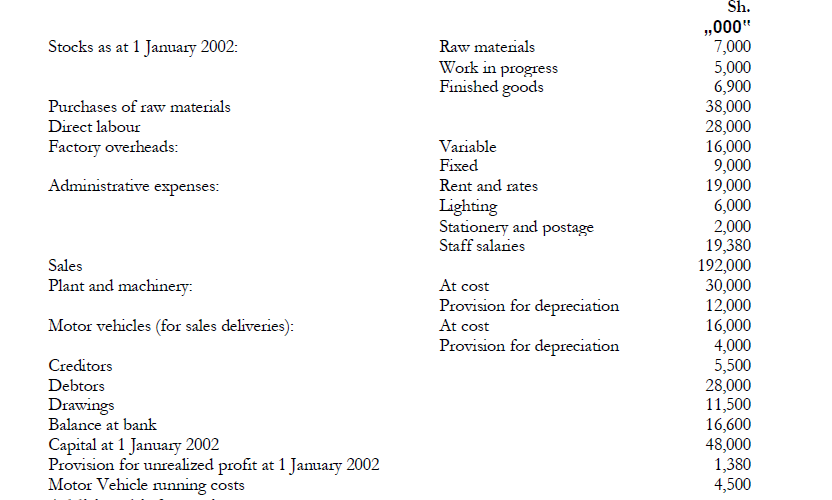

2. The factory output is transferred to the trading account at factory cost plus 25%
of factory profit.
3. Depreciation is provided at the rates shown below on the original cost of fixed
assets held at the end of each financial year.
Plant and machinery - 10% per annum
Motor vehicles - 25% per annum
4. Amounts accrued at 31 December 2002 for direct labour amounted to Sh. 3,000,000
and rent and rates prepaid at 31 December 2002 amounted to Sh. 2,000,000.
Required:
(a) Manufacturing, trading and profit and loss account for the year ended 31 December
2002.
(b) Balance sheet as at 31 December 2002.
Date posted:
November 17, 2018
.
Answers (1)
-
Denticare Limited makes its accounts on 30 June every year. On 1 July 2001, the company's balance sheet included the following figures for non -current...
(Solved)
Denticare Limited makes its accounts on 30 June every year. On 1 July 2001, the company's balance sheet included the following figures for non-current assets:

The company's policy is to charge depreciation at the following rates:

A proportionate charge is made in the year of purchase, sale or revaluation of an asset.
During the year ended 30 June 2002, the following transactions took place:
1. On 1 January 2002 the company decided to adopt a policy of revaluing its buildings. A
professional valuer engaged for this purpose revalued the buildings at Sh.34
million.
2. On 1 Janua ry a plant that had cost Sh.3 million was sold for Sh.500, 000. Accumulated
depreciation on this plant on 30 June2001 amounted to Sh.2.3 million. A new plant was
then purchased at a cost of Sh.4 million.
3. On 1 April 2002 a new motor vehicle was purchased for Sh.300, 000 Part of the
purchase price was settled by exchanging another motor vehicle at an agreed value of
sh.120, 000 The balance of Sh.180,000 was paid in cash. The vehicle which was given in
part exchange had cost Sh.200, 000 and had a net book value of Sh.100, 000 as at 30
June 2001
Required:
(a) The following ledger accounts to record the above transactions:
(i) Buildings account.
(ii) Provision for depreciation: Buildings.
(iii) Plant and machinery account.
(iv) Provision for depreciation: Plant and Machinery.
(v) Motor vehicles account.
(vi) Provision for depreciation: Motor vehicles.
(b) Property, plant and equipment movement schedule for the year ended 30 June 2002.
Date posted:
November 17, 2018
.
Answers (1)
-
Masaba Company Ltd. is a retail provider with an authorised share capital of 800,000 Sh.20 ordinary shares and 250,000 8% Sh.20 redeemable preference shares.
The following...
(Solved)
Masaba Company Ltd. is a retail provider with an authorised share capital of 800,000 Sh.20 ordinary shares and 250,000 8% Sh.20 redeemable preference shares.
The following financial information reflects the position of the company as at 31 December
2001 after preparing the Trading, profit and loss account:
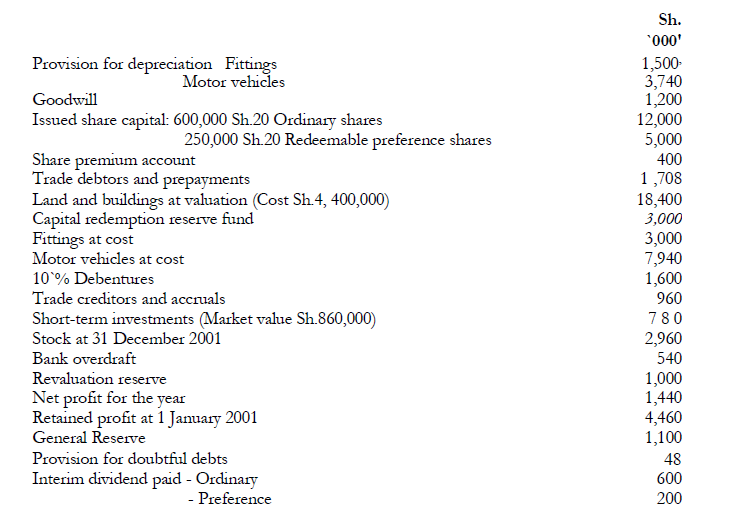
The following resolutions relating to year ended 31 December 2001 have been passed by the
board of directors of the company
1. Transfer Sh.500,000 to General Reserve.
2. Provide for 5% final dividend and final preference dividend on shares issued
and outstanding on 31 December 2001.
3. Make a bonus issue of 100,000 fully paid ordinary shares from the retained profits
account.
Required:
(i) The appropriations account of Masaba Company Ltd. for the year ended 31 December
2001.
(ii) The balance sheet of Masaba Company Ltd. as at 31 December 2001.
Date posted:
November 17, 2018
.
Answers (1)
-
Explain the legal provisions regarding the establishment and subsequent use of the following reserves: (i) Share premium account. (ii) Capital redemption reserve fund.
(Solved)
Explain the legal provisions regarding the establishment and subsequent use of the following reserves: (i) Share premium account. (ii) Capital redemption reserve fund.
Date posted:
November 17, 2018
.
Answers (1)
-
The Swara Sports Club had the following assets and liabilities as at 30 September 2002
(Solved)
The Swara Sports Club had the following assets and liabilities as at 30 September 2002:
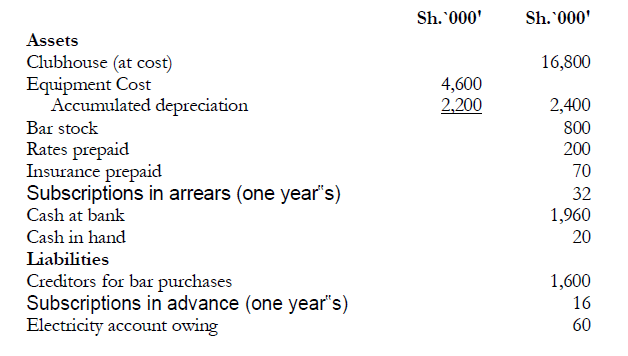
The treasurer of the club, Mr. Lutomia is in process of drawing up the financial forecast of
the club for the coming year, ending on 30th September2003.
He wishes to prepare a forecast income and expenditure account for the year and a balance
sheet as at that date.
The following information has been collected to assist in the forecast:
1. The club has 300 members and it is intended to raise the subscriptions per member
from the current Sh.8,000 to Sh.10,000 per year. The members who have paid in
advance will be allowed subscriptions at the old rates. It is anticipated that the members
currently in arrears with their subscriptions will pay the arrears during the coming year.
It is also anticipated that the number of members whose subscriptions would be in
arrears and those who would have paid in advance on 30 September 2003 would be the
same as the corresponding numbers on 30 September 2002.
2. Extensions to the clubhouse are planned which will cost an estimated amount of
Sh.3,000,000. Of this sum, it is anticipated that Sh.2, 000,000 will be paid during the
year.
3. Some of the club's sports equipment which cost Sh.500,000 and has a written value of
Sh.200,000 will be sold for u estimated value of Sh.100,000 and replaced by new
equipment costing Sh.680,000. All equipment is depreciated on a straight-line basis over
four years and none of the equipment is more than three years old. A full year's
provision is charged in the year of acquisition and none in the year of disposal.
4. Bar purchases are made monthly on credit and paid for in the month following
purchase. It is anticipated that the same volume of business, which is fairly constant on
a monthly basis, will be realised during the coming year but that stock costs will rise by
25% from 1 October 2002. Bar stocks are normally held at the level of one half of one
month's purchases. The bar makes a gross profit margin of 20% on all sales regardless
of stock costs. Bar sales are on cash, all of which is banked daily. The barman, who is
paid Sh.20,000 per month, receives a commission of 5% of the gross profit for the year.
This is paid with his final wage cheque by the year end.
5. The club runs monthly social evenings and charges members Sh.2, 000 per head
admission. An average of 200 members attend each of these evenings. Expenses usually
amount to Sh. 1,400 per head.
6. The following expenditure payments are expected to be made by the club during the
coming year:

The rates are paid on 1 January in respect of the following twelve months. The insurance
payment will be for the Period 1 April 2003 to 31 March 2004. One-fifth of electricity
consumption is in respect of the bar. All payments are made by cheque.
Required:
(a) Forecast bank account for the year ending 30 September 2003.
(b) Forecast bar. Trading, profit and loss account for the year ending 30 September 2003
(c) Forecast income and expenditure account for the year ending 30 September 2003.
(d) Balance sheet as at 30 September 2003.
Date posted:
November 17, 2018
.
Answers (1)
-
The following information has been extracted from the books of Mutero Traders Limited for the month of April 2002
(Solved)
The following information has been extracted from the books of Mutero Traders Limited for the month of April 2002.
Balances as at 30 April 2002:
Sales ledger credit balances 123.000
Purchases ledger debit balances 177,000
Required:
The sales ledger and purchases ledger control accounts for the month ended 30 April 2002.
Date posted:
November 17, 2018
.
Answers (1)
-
State the reasons for maintaining control accounts
(Solved)
State the reasons for maintaining control accounts.
Date posted:
November 17, 2018
.
Answers (1)
-
Kyamba, Onyango and Wakil were partners in a manufacturing and retail business and shared profits and losses in the ratio 2:2:1 respectively.
(Solved)
Kyamba, Onyango and Wakil were partners in a manufacturing and retail business and shared profits and losses in the ratio 2:2:1 respectively.
Given below is the balance sheet of the partnership as at 31 March 2001:
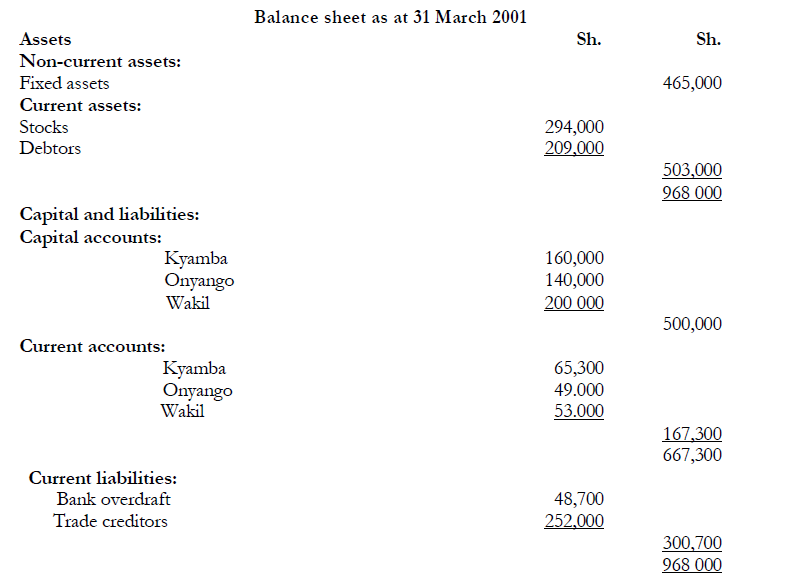
1. On 1 April 2001. Wakil retired from the partnership and was to start a business as a
sole trader while Kyamba and Onyango continued in partnership.
On retirement of Wakil, the manufacturing business was transferred to hum while
Kyamba and Onyango continued with the retail business.
2. The assets and liabilities transferred to Wakil were as follows:

Wakil obtained a loan from a commercial bank and paid into the partnership the
net amount due from him.
On retirement of Wakil from the partnership, goodwill was valued at Sh.200, 000 but
was not to be maintained in the books of the partnership of Kyamba and Onyango.
After retirement of Wakil on 1 April 2001. Kyamba and Onyango agreed on the
following terms and details of the new partnership:
Kyamba and Onyango to introduce additional capital of Sh.48,000 and
Sh.68,000 respectively.
Each partner was entitled to interest on capital at 10% per annum with effect
from 1 April 2001 and the balance
of the profits was to be shared equally after allowing for annual salaries of
Sh.72,000 to Kyamba and Sh.60,000 to Onyango.
5. The profit of the new partnership before interest on capitals and partners' salaries was
Sh.240, 000 for the year ended 31 March 2002.
6. The profits made by the new partnership increased stocks by Sh.100.000; debtors by
Sh.90.000 and bank balance by Sh.50, 000.
7. Drawings by the partners in the year were Kyamba Sh.85, 000 and OnyanSh go.70,000.
Required:
(a) Profit and loss and appropriation account for the year ended 31 March 2002.
(b) Capital accounts for the year ended 31 March 2002.
(c) Current accounts for the year ended 31 March 2002.
(d) Balance sheet of the new partnership as at 31 March 2002.
Date posted:
November 17, 2018
.
Answers (1)
-
The following information has been extracted from the accounts of Madaraka Investments Ltd.
for the year ended 31 December 2001. Comparable figures for the previous year...
(Solved)
The following information has been extracted from the accounts of Madaraka Investments Ltd.
for the year ended 31 December 2001. Comparable figures for the previous year are also shown.
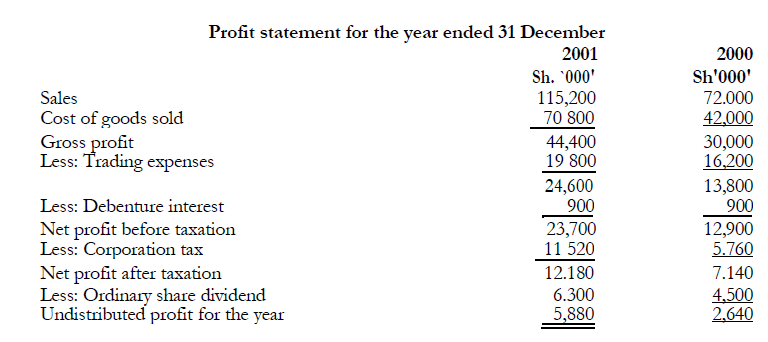
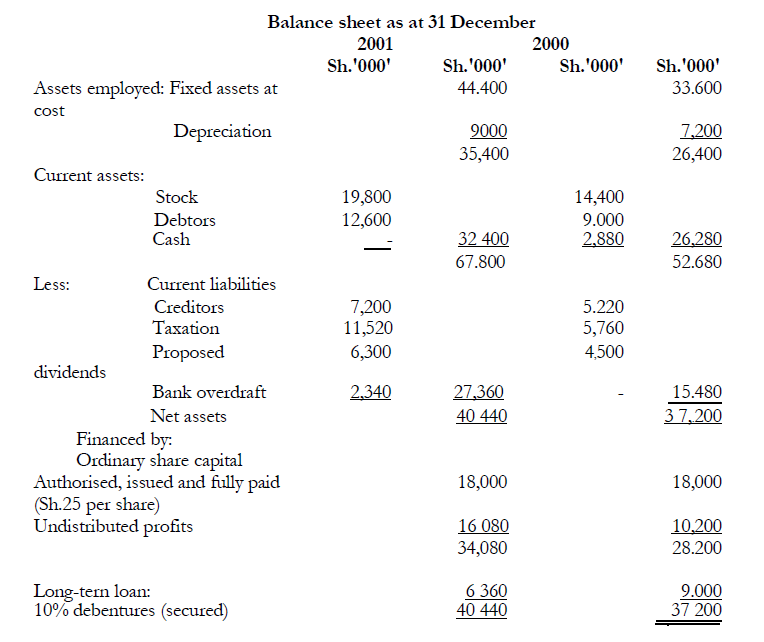
Required:
(a) Calculate six accounting ratios for both 2000 and 2001 that would help in assessing
the profitability and liquidity positions of Madaraka Investments Ltd. (12 marks)
(b) Comment on Madaraka Investment's liquidity position. (4 marks)
(c) Comment on Madaraka Investment's profitability position. (4 marks)
Date posted:
November 17, 2018
.
Answers (1)
-
On 31 December 2001. an inexperienced book-keeper working for Wanji, a sole trader,
extracted a trial balance. Due to errors committed by the book-keeper, the trial...
(Solved)
On 31 December 2001. an inexperienced book-keeper working for Wanji, a sole trader,
extracted a trial balance. Due to errors committed by the book-keeper, the trial balance failed to
balance by Sh.369.400. He placed the difference in a suspense account as shown below:
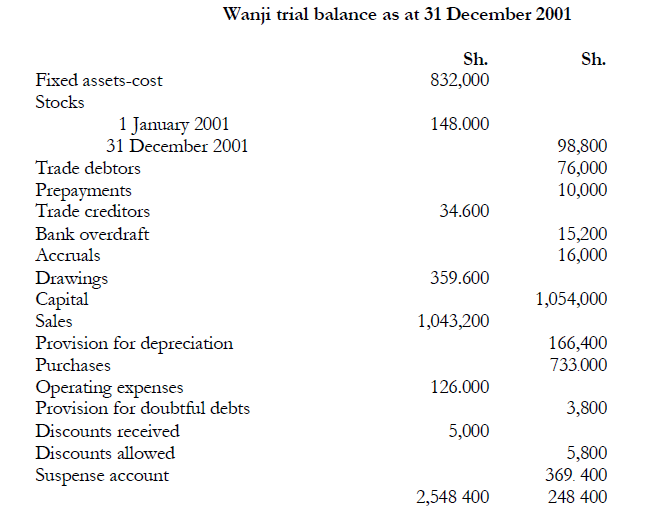
Investigations carried out after preparing the above trial balance detected the following errors:
1. The total of the sales day book for December 2001 was overcast by Sh.25,700.
2. On 2 July 2001 the business purchased office equipment for Sh.40 .000. These were
debited to purchases account.
3. Depreciation on the equipment is at the rate of 10% per annum on cost and based on
the period (months) of usage in the year.
4. A payment to a creditor by cheque of Sh.8.500 was erroneously credited to the
creditor's account.
5. A payment of Sh.4.500 for telephone expenses was debited to telephone account as
Sh.5.400.
6. An amount of Sh.15.000 received from a debtor was not posted to the
debtor's account from the cash book.
7. An amount of discounts received of Sh.2.500 was debited to discounts
allowed account.
8. Purchases day book for October 2001 was undercast by Sh.28,000.
9. Assume the business had reported a net profit of Sh.85,800 before adjusting for the
above errors.
Required:
(a) The adjusted trial balance and the correct balance of the suspense account
(b) Journal entries to correct the errors (Narrations not required)
(c) Suspense account starting with the balance determined in the adjusted trial balance in (a)above.
(d) The adjusted net profit for the year.
Date posted:
November 17, 2018
.
Answers (1)
-
Ssemakula, a sole trader received his bank statement for the month of June 2001. At
that date the bank balance was Sh.706,500 whereas his cash book...
(Solved)
Ssemakula, a sole trader received his bank statement for the month of June 2001. At
that date the bank balance was Sh.706,500 whereas his cash book balance was
Sh.2,366,500. His accountant investigated the matter and discovered the following
discrepancies:
1. Bank charges of Sh.3, 000 had not been entered in the cashbook.
2. Cheques drawn by Ssemakula totaling Sh.22,500 had not yet been
presented to the bank
3. He had not entered receipts of Sh.26,500 in his cashbook.
4. The bank had not credited Mr. Ssemakula with receipts of Sh.98, 500 paid into the bank
on 30 June 2001.
5. Standing order payments amounting to Sh.62, 000 had not been
entered into the cashbook.
6. In the cash book Ssemakula had entered a payment of Sh.74, 900
Sh.79400.
7. A cheque for Sh. 15,000 from a debtor had been returned by the bank ma rked "refer to
drawer" but had not been written back into the cashbook.
8. Ssemakula had brought forward the opening cash balance of Sh.329, 250 as a debit
balance instead of a credit balance.
9. An old cheque payment amounting to Sh.44, 000 had been written back in the
cashbook but the bank had already honoured it.
10. Some of Ssemakula's customers had agreed to settle their debts by paying directly into
his bank account. Unfortunately, the bank had credited some deposits amounting to
Sh.832, 500 to another customer's account. However, acting on information from his
customers, Ssemakula had actually entered the expected receipts from the debtors in his
cashbook.
Required:
(i) A statement showing Ssemakula's adjusted cash book balance as at 30 June 2001.
(ii) A bank reconciliation statement as at 30 June 2001.
Date posted:
November 16, 2018
.
Answers (1)
-
Explain the term "bank reconciliation" and state the reasons for its preparation
(Solved)
Explain the term "bank reconciliation" and state the reasons for its preparation.
Date posted:
November 16, 2018
.
Answers (1)
-
The accountant of Mamba Sports Club has extracted the following information from
the books of account for the year ended 31 March 2001:
(Solved)
The accountant of Mamba Sports Club has extracted the following information from
the books of account for the year ended 31 March 2001:
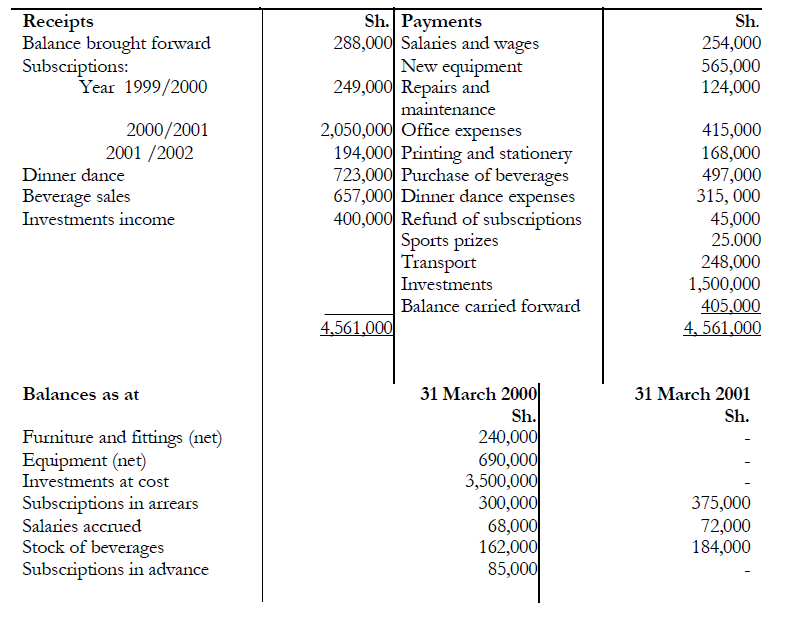
Additional information:
1. Subscriptions in arrears are written-off after twelve months.
2. Depreciation is provided for on reducing balance method at 10% and 20% per
annum on furniture and fittings and equipment respectively.
3. Investments, which had cost Sh.500, 000 were sold on 30 March 2001 for Sh.625,000. No entries have been made in the books in this respect.
Required:
(a) Income and expenditure account for the year ended 31 March 2001.
(b) Balance sheet as at 31 March 2001.
Date posted:
November 16, 2018
.
Answers (1)
-
Rotich and Sinei have been in partnership for several years, sharing profits and losses in the
ratio 2:1. Interest on fixed capitals was allowed at the...
(Solved)
Rotich and Sinei have been in partnership for several years, sharing profits and losses in the
ratio 2:1. Interest on fixed capitals was allowed at the rate of 10% per annum, but no interest
was charged or allowed on current accounts.
The following was the partnership trial balance as at 30 April 2001:
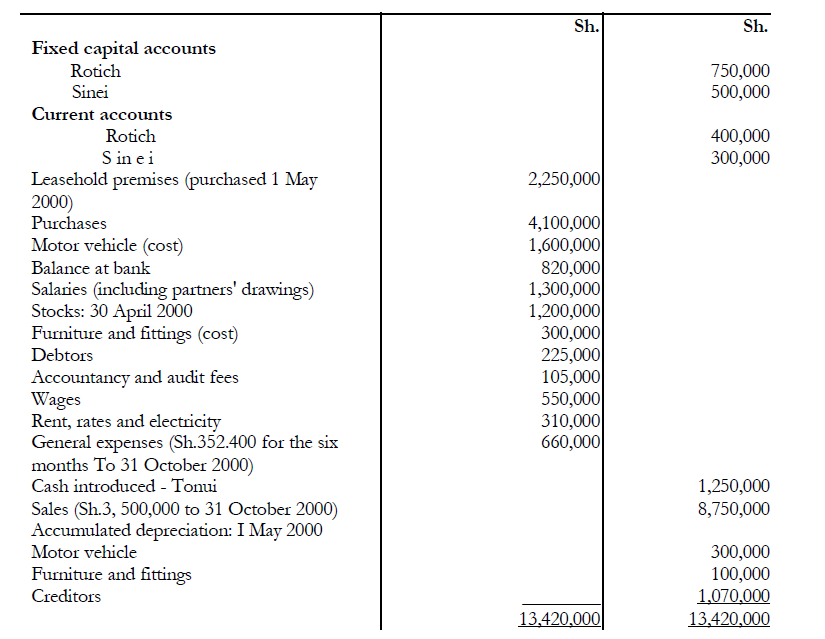
Additional information:
1. On 1 November 2000,'Tonui was admitted as a partner and from that date, profits and
losses were shared in the ratio 2:2:1. For the purpose of' this admission, the value of
goodwill was agreed at Sh.3, 000,000. No account for goodwill was to be maintained in the
books, adjusting entries for transactions between the partners being made in their current
accounts. On that date, Tonui introduced Sh.1, 250,000 into the firm of which Sh.375, 000
comprised his fixed capital and the balance was credited to his current account
2. Interest on fixed capitals was still to be allowed at the rate of 10`%, per annum after Tonui
admission, no interest was to be charged or allowed on current accounts.
3. Any apportionment of gross profit was to he made on the basis of sales. Expenses, unless
otherwise indicated, were to be apportioned on a time basis.
4. A charge was to be made for depreciation on motor vehicle and furniture and fittings at
20%and I0% per annum respectively, calculated on cost.
5. On 30 April 2001, the stock was valued at Sh. 1,275,000.
6. Salaries included the following partners' drawings:
Rotich Sh.150,000 , Sinei Sh. 120,000 and Tonui Sh.62,500
7. A difference in the books of Sh.48, 000 had been written off at 30 April 2001 to
general expenses, which was later found to be due to the following clerical errors:
- Sales returns of Sh.32, 000 had been debited to sales returns but had not
been posted to the account of the customer concerned;
- The purchases journal had been under cast by Sh.80, 000.
8 Doubtful debts (for which full provision was required) amounted to Sh.30, 000 and Sh.40,
000 as at 31 October and 30 April 2001 respectively.
8. On 30 April 2001, rates and rent paid in advance amounted to Sh.50,000 and a provision
of' Sh.15,000 for electricity consumed was required.
Required:
(a) Trading and profit and loss account for the year ended 30 April 2001,
(b) Partners current accounts for the year ended 30 April 2001.
(c) Balance sheet as at 30 April 2001.
Date posted:
November 16, 2018
.
Answers (1)
-
Nafuu Foods Ltd. is a company in the hospitality industry. The following trial balance has
been extracted from its books on 31 October 2001
(Solved)
Nafuu Foods Ltd. is a company in the hospitality industry. The following trial balance has
been extracted from its books on 31 October 2001:
You are provided with the following additional information:
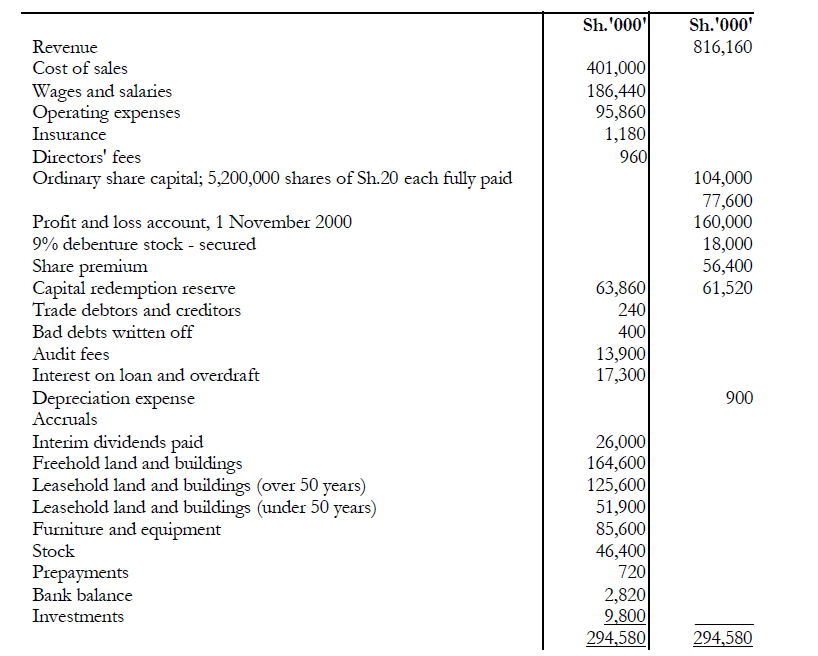
1. The balances of fixed asset accounts as at the beginning of the year and additions during
the year were as follows:

a. The company does not provide for depreciation on freehold properties or
properties held on lease with 50 years or more to run at the balance sheet date.
Properties held on lease with less than 50 years to run are depreciated over the
unexpired term. Items of equipment are depreciated over their estimated useful
life.
2. Some of the leasehold property in the books costing Sh.7, 500,000 had just 50 years
remaining on the lease in October 2000 and has not yet been transferred to the under
50 years category.
3. Disposals during the year included the following:

All the sale proceeds have been included in the revenue; no other adjustment has
been made.
The determination of depreciation expense for the year included in the trial balance
above has correctly been done for those properties not disposed of and included in
the under 50 years category at the beginning of the year.
4. Freehold land was revalued on an existing use basis by a professional valuer but the
Surplus of Sh.6,000.000 has not yet been brought into account.
5. The investments in the trial balance are temporary quoted securities. As at 31
October 2001 their market value was Sh.10,500,000. Income from the investments
of Sh.450,000 is included in revenue
6. Additional audit fees of Sh.600,000 need to be provided for.
7. The total balance of cash at bank includes Sh. 1,500,000 overdraft on one of the
accounts.
8. The corporation tax oil the year's profit has been estimated at Sh.27,000,000.
Corporation tax on the previous years profit was finally agreed with the tax authorities
to be Sh.3 10,000 more than had been provided for in the profit and loss account of
the year.
The directors have decided to recommend a final dividend of Sh.5 per ordinary share.
Required:
(a) A schedule showing fixed assets movements for the year ended 31 October 2001.
(b) Profit and loss account for the year ended 31 October 2001.
(c) Balance sheet as at 31 October 2001.
Date posted:
November 16, 2018
.
Answers (1)